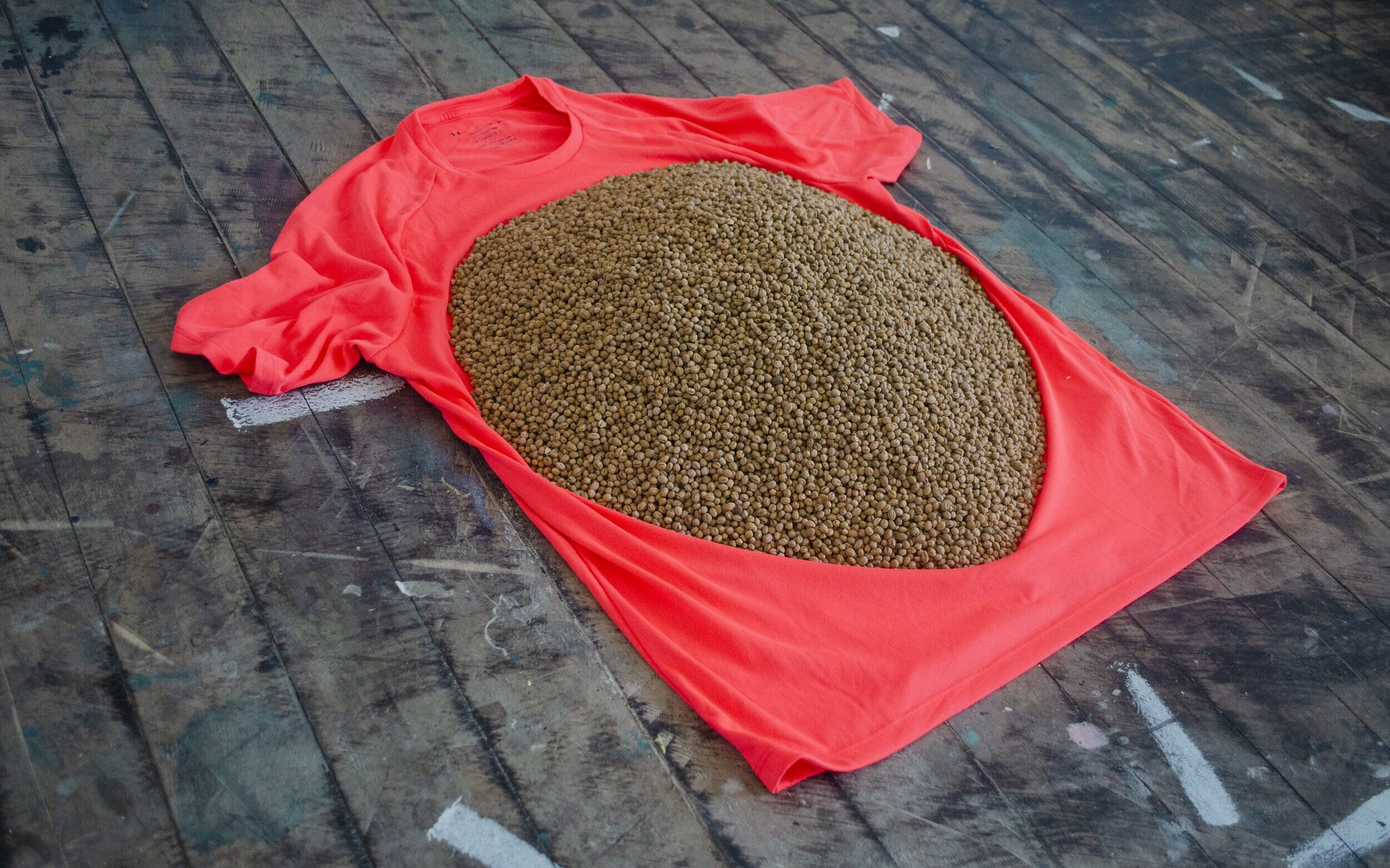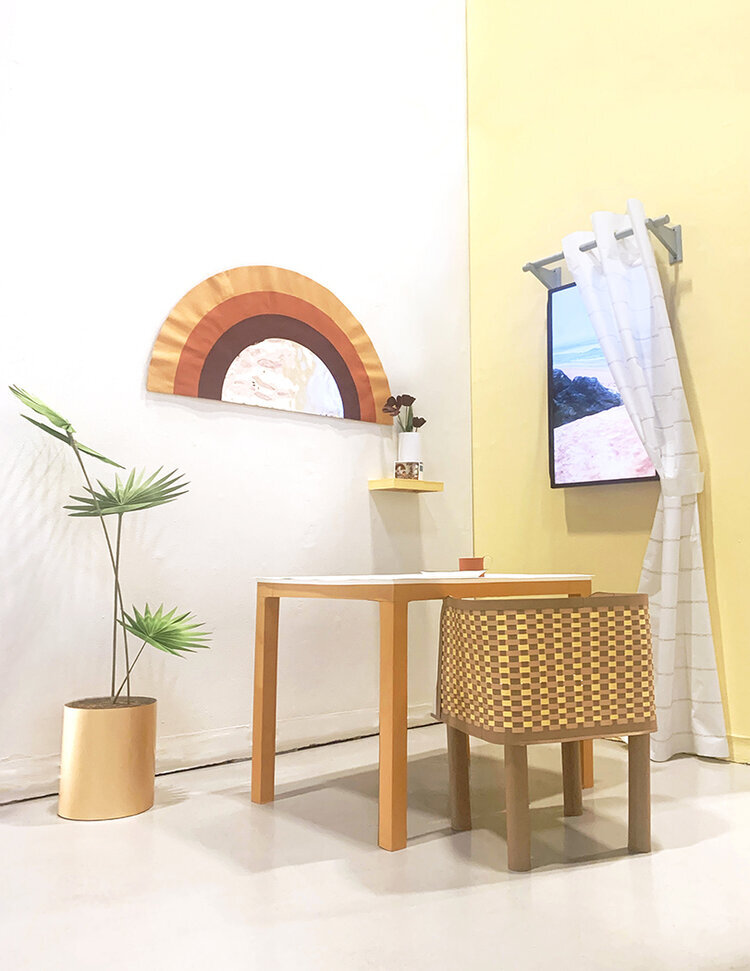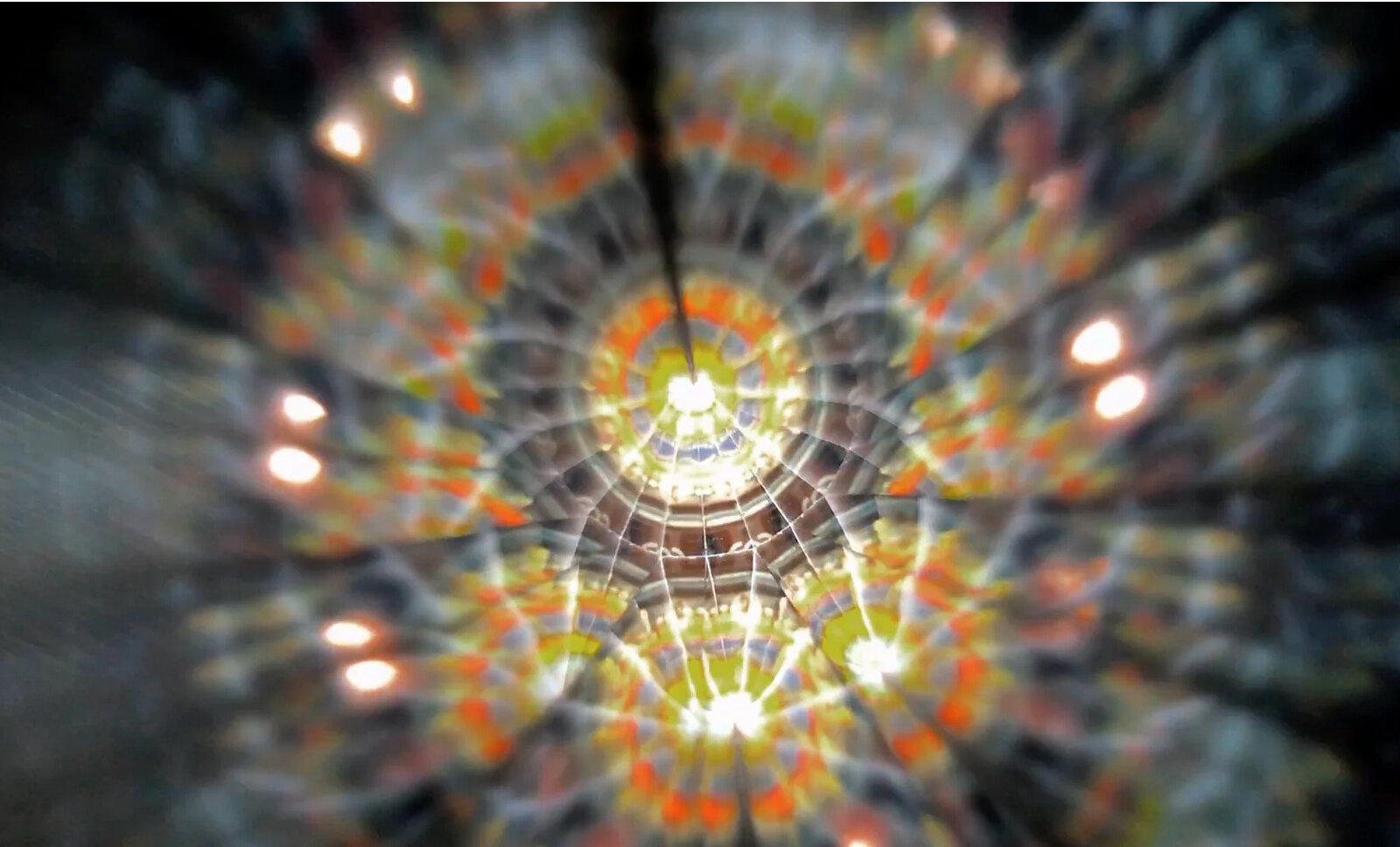calum craik
san francisco state university
Calum Craik, Double Uniqlo, 2019
Two Uniqlo down vests, two USB cords, resin
40 in. x 24 in. x 12 in.
Image courtesy of the artist
Born in Scotland, CALUM CRAIK has been working and exhibiting in the United States for eight years, with time spent in both New York City and San Francisco. With a recent MFA from San Francisco State University, he works in both sculpture and performance. Calum’s interdisciplinary practice explores material culture, economics, and the effects of neoliberal capitalism while layering in memories of his family and childhood in Scotland. Calum’s perspective on what he calls the “invisibility of neoliberalism” is an open critique on contemporary culture, especially that surrounding Bay Area tech environments.
Calum Craik with Bex Robinson-Craik, Flag of Convenience III, 2020
Yoga pants, thread, wood
72 in. x 60 in. x 3 in.
Image courtesy of the artist
One phenomenon that Calum references and critiques in his visual work is yoga classes for office workers. In the piece Flag of Convenience, he has deconstructed yoga garments and sewn the fragments back together, finally stretching the reconfigured patchwork on traditional stretcher bars. The resulting abstraction consists of bright red, white, and blue nylon/spandex fabrics that create shapes that are recognizable as a waistband, a pant leg with a pocket, or an arm panel. Evidence of various “high-end” brands are included in the composition. The sewing, though by machine, is rough and puckers and pulls in places, which adds to the humor of this work.
Calum Craik
Under Armour (enclosed), 2020
Under Armour T-shirt, Hawthorn seeds
30 in. x 22 in. x 6 in.
Image courtesy of the artist
Calum also uses narratives from his family history to reference labor, housing, and privatization policy. In the piece Under Armour (enclosed), an intense, almost glowing red Under Armour brand T-shirt provides a surface on the floor that is topped with a significant pile of earthy Hawthorn seeds. Historically in Great Britain and other parts of Europe, landowners used hedges to enclose common fields for their own use, privatizing rural land, which in turn created an industry to supply Hawthorn seeds to be used in creating hedgerows. The shrubs and trees were grown to contain or enclose land, providing natural barriers, some dating to the medieval period. To Craik, these botanical walls, though attractive compared to alternative methods of fencing, still represent barriers, privatization, and wealth. The thin, synthetic Under Armour platform beneath the heap of seeds reinforces the critique with a layer that to Calum represents contemporary entitlement.
Calum Craik
Fields Divided by Drystone Walls, 2019
Memory foam, found defensive landscaping rocks, and rocks from private building development sites
80 in. x 40 in. x 6 in.
Image courtesy of the artist
In the piece Fields Divided by Drystone Walls, Craik has arranged found landscaping rocks on a sheet of memory foam. As predicted, the weight of the stones indents the foam pad slightly, creating the appearance that the stones are embedded in this synthetic material. As is the case with many of Calum’s pieces, there is a nice balance between a serious critique and a welcomed sense of humor.
Visit Calum’s website
Follow Calum on Instagram
Q & A
Calum at Headlands
BAC: In talking about your work you use the word neoliberalism, which you describe as the privatization of things in the public sphere. What are some current examples of free items being turned into capitalist goods that you are looking at?
Craik: Neoliberalism is the privatization of the common, it’s the force which enables Amazon to avoid tax, it’s the zero-hour contract, it’s an opportunity for the banks to play with your savings on the market, it’s public land and housing becoming private, it’s the computer algorithm foreclosing your future — ultimately, it’s the financialization of all possible human interaction and social bonds.
My art practice aims to question the aesthetic, social, and cultural effects of Neoliberal capitalism but also our complicity. I investigate the embedded power relations in the spaces we inhabit, lifestyles we live, and the jobs we do. Neoliberalism is the major cause of precarity in our time. I aim to challenge the way neoliberal ideology functions and the materials and spaces which are emblematic of these functions. I investigate phenomena including housing, public/private space, and changes within labor and technology, as well as associated cultural artifacts that incorporate neoliberal values, such as clothing and packaging. Some of the materials and spaces have personal significance, like using a piece of carpet from my childhood bedroom in my parents’ council flat, to more everyday artifacts, such as worker uniforms like Patagonia jackets.
BAC: Besides your visual art practice, you also write. Can you speak to these two separate practices and how they intersect?
Calum: My publication-based works use a form of distribution that can engage with an audience outside the traditional gallery context. The ease of distribution can allow the works to be viewed in almost any space: work, transport, and domestic settings. I aim for these works to intervene into spaces where art isn’t often viewed.
The writing anchors the rest of my work and allows me to be a bit looser in my sculpture. The content of the writing is a narrative version of how I approach my sculptures, which layer materials, history, and social relations together to create a new awareness of how these objects or spaces function in an ideological sense. The writing usually follows a character — in the short story “IPA (flatten),” for instance, a tech worker who lives in a live/work space. It follows the worker through their day, where they embark on a 48-hour coding competition for which the prize is tickets to a craft brewery. The writing references physical materials such as steel and the tinted glass of the converted warehouse space, but also associated activities of the workplace such as yoga, in which the practice has been co-opted by the neoliberal capitalist wellness market to increase worker productivity and individualism.
BAC: Has the pandemic altered how you think of your work or practice?
Calum: I have had to shelve a few ideas such as a social practice piece titled The Precarious Workers Football Club, which involves groups of people coming together to create a soccer team. I have thought about how works can be viewed online but also how works can be discovered outside, like at the Headlands, where my studio is at the moment.
BAC: Various sporty/outdoor fabrics are featured in your work. For example, in Double Uniqlo, you have incorporated two puffy outdoor vests into your sculpture. Can you address your focus on these particularly contemporary fabrics and/or outdoor-sy styles in your work?
Calum: These works reference contemporary worker outfits, particularly ones associated with tech. I have also been using brands like LuluLemon, Patagonia and Under Armour. These brands often aim to use performance technology and are about growth, expansion, and comfort – neoliberal capitalist ideals. The brands to me signify the collapsing of the ideas of work and leisure into a singular garment. Under Armour is perhaps more complex as it has a military connection too.
BAC: You're currently at Headlands with a Graduate Fellowship Award – congratulations! What are you planning to do at Headlands and where can we see your work next?
Calum: Thanks! I feel very lucky to be there. While at Headlands I plan to further examine the effects of neoliberal capitalism on the surrounding landscape, labor, and social relations. The Headlands’ unique position at the opening of the bay presents many overlapping histories to draw from. I am interested to work in a less built up environment and see how that influences my work.












